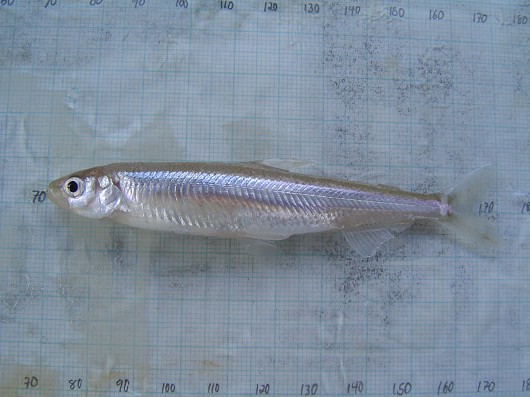Wakasagi
-
Scientific NameHypomesus nipponensis
-
NativeNo
-
Identification
 Wakasagi, captured in rotary screw trap on the Sacramento River at Knight's Landing on 2/26/2009. Photo by Dan Worth, California Department of Fish and Game.
Wakasagi, captured in rotary screw trap on the Sacramento River at Knight's Landing on 2/26/2009. Photo by Dan Worth, California Department of Fish and Game.- Slender bodied
- Small mouth with a maxilla that does not extend past the midpoint of the eye
- Relatively large eyes
- Small pointed teeth
- Pectoral fins reach less than 2/3 of the way to the base of the pelvic fins
- 8-11 dorsal, 8 pelvic, 11-14 pectoral, and 14-17 anal fin rays
- Incomplete lateral line with 54-60 scales
- 4-7 pyloric caeca
- Nearly translucent with a steely blue sheen
- 5-77 chromatophores on the isthmus between the mandibles
-
Life History
Wakasagi are pelagic plankton feeders found in open lakes, streams and reservoirs. They can survive in a wide range of temperatures (2-29°C) and salinities (0-29 ppt). Copepods and insect larvae appear to make up the majority of their diet. Anadromous populations are known to exist in their home range in Japan but this behavior has yet to be observed in California. They have been observed schooling in the Sacramento-San Joaquin Delta, in contrast to the more solitary delta smelt with which they share habitat and occasionally hybridize. Most wakasagi live for 1-2 years, spawn, and then die. Spawning occurs between April and May in shallow areas of sand or gravel. The free swimming juveniles grow quickly reaching 73 mm by their first spawning and 94 mm at their second reaching maximums near 120 mm.
California information is mainly based on one study in the Lake Shastina Reservoir in the Shasta River watershed; variations in behavior and life history of other populations is possible.
-
Links to Other ResearchN / A
